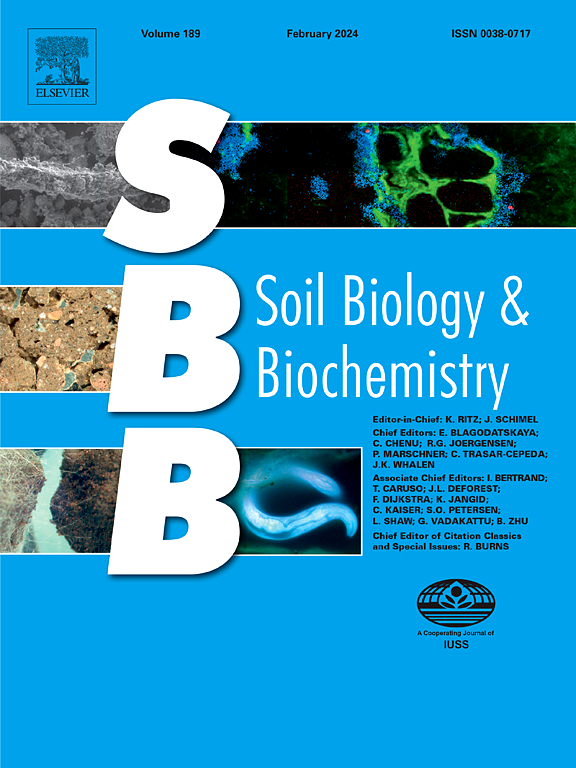Warming increases CH4 emissions from rice paddies through shifts in methanogenic and methanotrophic communities
IF 9.8
1区 农林科学
Q1 SOIL SCIENCE
引用次数: 0
Abstract
Warming often stimulates methane (CH4) emissions from rice paddies, one of the largest anthropogenic sources of CH4 emissions. However, the responses of methanogenic and methanotrophic communities to warming, particularly within active communities, remain unclear. Therefore, based on a field warming experiment in a rice-wheat system, we investigated the effects of warming on methanogenic and methanotrophic communities, using the DNA stable-isotope probing technology. Our results indicated that warming increased CH4 emissions by 27–49% over two rice growing seasons compared to ambient conditions. Warming significantly increased the abundance of methanogens by 53%, whereas did not affect activities of methanogens and active methanogenic community. Conversely, warming did not influence the abundance of methanotrophs, but reduced activities of methanotrophs by 44%. Notably, warming led to a significant rise in the relative abundance of the active type II methanotrophic community, which exhibits lower CH4 oxidation efficiency. These findings suggest that the observed increase in CH4 emissions under warming conditions is primarily driven by the enhanced abundance of methanogens and the increased presence of less efficient active type II methanotrophs. This study underscores the critical role of active microbial communities in understanding and managing CH4 emissions from rice paddies in a warming world.
气候变暖通过甲烷发生群落和甲烷营养群落的变化增加稻田的甲烷排放量
气候变暖通常会刺激稻田的甲烷(CH4)排放,而稻田是最大的人为甲烷排放源之一。然而,甲烷发生群落和甲烷营养群落对气候变暖的反应,尤其是在活跃群落中的反应,仍不清楚。因此,我们在水稻-小麦系统田间增温实验的基础上,利用DNA稳定同位素探测技术研究了增温对甲烷发生群落和甲烷营养群落的影响。结果表明,与环境条件相比,在两个水稻生长季中,气候变暖使甲烷排放量增加了 27-49%。气候变暖使甲烷菌的丰度明显增加了 58%,但并不影响甲烷菌的活性和活跃的甲烷菌群落。相反,气候变暖并不影响甲烷营养体的数量,但却使甲烷营养体的活动减少了 44%。值得注意的是,气候变暖导致活跃的 II 型甲烷营养群落的相对丰度显著上升,而 II 型甲烷营养群落的 CH4 氧化效率较低。这些发现表明,在气候变暖条件下观察到的CH4排放量增加主要是由甲烷菌的丰度增加和效率较低的活性II型甲烷营养体的增加所驱动的。这项研究强调了在气候变暖的世界中,活性微生物群落在了解和管理稻田甲烷排放中的关键作用。
本文章由计算机程序翻译,如有差异,请以英文原文为准。
求助全文
约1分钟内获得全文
求助全文
来源期刊

Soil Biology & Biochemistry
农林科学-土壤科学
CiteScore
16.90
自引率
9.30%
发文量
312
审稿时长
49 days
期刊介绍:
Soil Biology & Biochemistry publishes original research articles of international significance focusing on biological processes in soil and their applications to soil and environmental quality. Major topics include the ecology and biochemical processes of soil organisms, their effects on the environment, and interactions with plants. The journal also welcomes state-of-the-art reviews and discussions on contemporary research in soil biology and biochemistry.
 求助内容:
求助内容: 应助结果提醒方式:
应助结果提醒方式:


